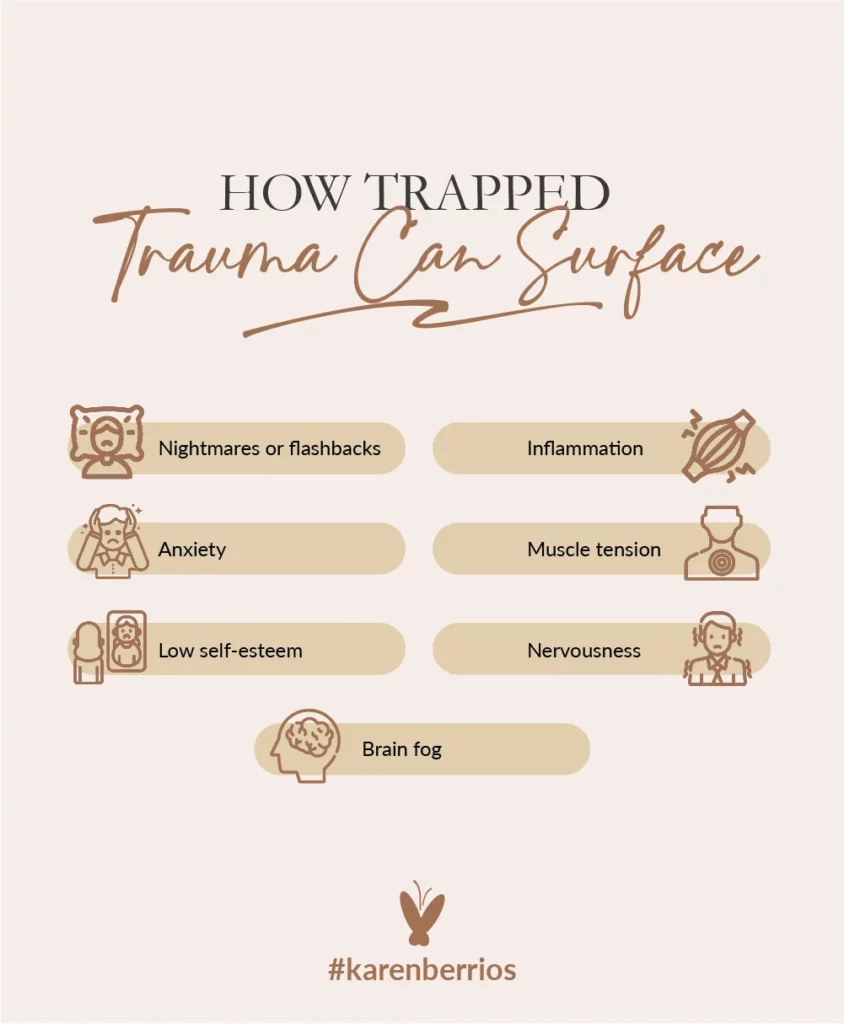

How Is Trauma Held In The Body?
Held In The Body. In my thyroid cancer healing journey, I have learned so much about the many different types of healing protocols one can follow to heal from cancer. It is not only about what we eat but also our emotions, our thoughts, and spiritual life. One of my doctors used to say, “a bad thought can kill you faster than some bad bacteria”. So much wisdom behind that sentence!
Emotional healing was an area I refused to work on the first three years of my journey. Every time I had an appointment with a therapist I dreaded it and I will always look to sabotage the work I had to do with my emotions. Eight years forward, I must say that I am in a different place and without doubt I can say that most cancers are rooted in emotions and this an area that everyone should work on. It is hard work, especially because it requires you to accept and face pain and the damage this pain has caused in you and/or those you love. While an emotional healing journey may be painful, the light at the end of the tunnel will make it all worth it.
My thyroid cancer diagnosis has been my mentor, because it gave me an opportunity to learn things I didn’t know like how trauma can be stored in our bodies. This is shocking!! Symptoms in our bodies tell us stories, our bodies reflect our subconscious mind. Looking into the root cause will always bring opportunity to heal and change.
Unveiling And Understanding Trauma
I have learned that trauma can stem from childhood and influence our behaviors, thoughts and wellbeing way into adulthood. We can store remnants of our traumatic experiences in the subconscious mind, which may surface when we are triggered. Unfortunately, trauma is nothing unique to most of us, and MindBodyGreen estimates 70% of people have experienced a traumatic event. You may find yourself wondering what trauma is, and may even question the depth of your traumatic experiences.
According to the American Psychological Association, trauma is best defined as “an emotional response to a terrible event.” These events can be anything from a natural disaster, to sexual assault, or accidents. Before we discuss how trauma is stored in the body, let’s review and unpack the 3 main trauma types. Medicinenet.com cites 3 main trauma types that can be stored in the body, mind and spirit, which include:
- Acute trauma
- Chronic trauma
- Complex trauma
Acute trauma can manifest as panic attacks, irritation, and confusion after an isolated traumatic event. Next, chronic trauma occurs as a result of someone experiencing severe, ongoing trauma like abuse and illnesses/accidents. As a result of multiple exposures of these traumatic events, the individual will have frequent bouts of anxiety, headaches or migraines, can be insecure, or become hesitant in certain situations.
Finally, complex trauma is a result of several or combined types of trauma. For example, someone who has been bullied, has illnesses and is repeatedly abused may suffer complex trauma. The memories and emotions of these experiences can be stored in the body and surface through headaches, difficult mental health conditions, and in erratic behavior. It may be helpful to focus on releasing trauma at this stage, even if that includes making healthy lifestyle changes or attending therapy.
How Trapped Trauma Can Surface
The effects of traumatic and distressing experiences can remain stored in different parts of our body and surface at any moment. According to several sources, trauma is stored in the tissue and muscles, which cause physical pain and discomfort. Now, let’s explore what trauma can look like, and some ways the body holds trauma. Traumatic experiences can manifest in several ways psychologically, physically and emotionally, such as, but not limited to:
- Nightmares or flashbacks
- Anxiety
- Low self-esteem
- Inflammation
- Muscle tension
- Nervousness
- Brain fog
- Digestive or stomach issues
- Hallucinations
- Fatigue or chronic fatigue
- Physical ailments like headaches or stomach pains
- Addictions or compulsions
The ways unprocessed or unhealed trauma shows up in the body can depend on the types of trauma someone has experienced, as well as any treatment they have received for it. Some factors are more complex and others simple. For some, unhealed traumas can be a motivating factor to self-medicate by using drugs or alcohol to self-soothe. However, for others, trauma can be a motivating factor to transform their lives and overcome any feelings of victimhood they may have experienced. Fortunately, you don’t have to allow your trauma to dictate the course of your life, and it’s important to have compassion for yourself.
We can see other examples of trauma storing itself in the body when people who experience Post-Traumatic Stress Disorder react when placed in a similar situation to a past traumatic experience. In response, he or she may unconsciously avoid similar experiences, or anticipate fear in similar situations that may have a different outcome. He or she may have nightmares or panic attacks.
Let’s use an example to connect trauma to avoiding similar situations to protect ourselves. Imagine you endured a near-death experience as a child via drowning. As you’ve aged, you may have learned how to suppress the fear of drowning in different ways. However, you react one day after being triggered, fearing to jump into a pool. You may show symptoms of a panic attack, or become nervous or hostile. Everyone’s behavior trauma will be different, but it explains ways unprocessed trauma can haunt us.
Trapped Trauma And Health Conditions In The Body
Despite trauma manifesting in the body through the mind, the mind-body connection of trauma and stress remains strong. Since trauma is stored in the tissue, it is no surprise this condition can result in painful health conditions. An NCBI study covers this when explaining this connecting trauma and distress with patients who have fibromyalgia. Upon surveying over 100 women, they found anxiety and mood disorders “more prevalent” with women who have fibromyalgia. In addition, the group of women who had the condition had more cases of childhood trauma. While there are several other conditions connected to trauma, we can see the emotion-somatic connection here.
Another way the body holds trauma and reveals itself is through cycles in women’s bodies. In this case, trauma for women can show up in specific parts of their bodies associated with their sexual organs and womb. For women, our wombs are our centers that bring life into the world. Women also regulate their menstrual cycles with the womb. Any trauma done to this part of the body can yield heavy menstrual cycles. To add, while endometriosis or PCOS may not always be the result of trauma, there are some connections between the two. To put this into perspective, a MindBodyGreen article notes the connection between a woman, trauma and extremely painful cycles. Further, the article demonstrates connections between sexual trauma being stored within her womb and its impact on her life. Additionally, if women have traumatic womb-connected experiences, they may be holding tension in their hips, as this is believed to hold emotion and tension in some cultures. When exercising, they can hold tension there, and stretching out the tension can release unprocessed trauma.
For men, unprocessed trauma can be stored in the body, but manifest as violent or aggressive acts. Due to social stigmas that call for men to repress or bypass their emotions, men often feel they don’t have a safe space to cry or express their feelings. As a result, they can bottle up their emotions, and release that on unsuspecting or innocent people. In addition to the above examples of health conditions as a result of stored trauma in the body and mind, we can see the following surface:
- Headaches
- Neck pain
- Body stiffness
- Tension
- Gastrointestinal issues
It’s worth mentioning that not all digestive issues stem from traumatic experiences, however, there are connections to trauma and diseases and malfunctions of the gastrointestinal tract. When stressed or undergoing trauma, we may not eat the healthiest foods, or we may reduce our nutritional intake. If we are depressed from traumatic experiences, we may lose our self-care and not want to be bothered with eating the right foods. After repeated stressful experiences, our body goes into fight or flight mode, increasing cortisol production. Additionally, ulcers, stomach pains, and digestive issues like Irritable Bowel Syndrome, or nausea can emerge. Other gut-related conditions can occur like leaky gut syndrome can show up in ways trauma stores itself in the body. There is much research that goes into defining and diagnosis this syndrome, however, this condition can involve the following symptoms:
- Aches and pains
- Digestive problems
- Gas or bloating
- Cramping
- Food intolerance

Releasing Trauma in the Body
Despite trauma contributing to a variety of emotional, mental, or physical symptoms, there are ways to release it. The more we live a life that includes peace, fun, and relaxation, perhaps we can reduce some of these symptoms. One of the most traditional ways to release trapped trauma is through therapy. Getting professional healing can shine a light on the darkness trauma may cause. There are other techniques you can use to release trapped trauma, including:
- EFT tapping
- Acupuncture
- Meditation
- Medications or supplements
- Yoga or stretching
- Deep, controlled breathing
- Dance
- Devotionals, prayer, or words of power/faith
- Therapy (Art and music therapy)
- Diet: prebiotics(Yacon)
EFT tapping allows us to relax tissues and tense muscles in the body with tapping sensations. When we tap specific points of the body, the result can result in relaxation, and subconscious reprogramming. Secondly, making dietary choices can help GI issues related to trauma. Eating certain fruits and vegetables can calm the nervous system. Prebiotics (found in Yacon) and probiotics (found in yogurt) can provide gastric relief. Acupuncture for trauma helps relax muscles by placing small, non-painful needles into the body. Although much research is being done, people can experience relaxed states of mind and can release trapped emotions. Lastly, journaling can also help us release emotions safely.
Final Reflections
Praying can build faith and teach us the value of acceptance of circumstances we don’t understand. It can also give us peace for unresolved conflict. Understanding everything happens for a reason, or that we are still worthy of God’s love can give us strength. We can also learn how to forgive others and ourselves and release the trauma. We can remember to enjoy life and go with the flow, making the most of each moment. If you need inspiration and connection to God, consider reading my devotionals, here. Remember you are loved, despite any trauma you may have faced, and you are highly loved and accepted by our Heavenly Father. God bless you with much healing and peace!

hey there
I'm Karen!
I have found my cancer journey to be a positive and profound transformational experience. I’m inspired to share my healing journey here, and trust you’ll find hope, encouragement and purpose as you discover the healing power that lies within you.
Join
The Mailing List!
By signing up for my newsletter, you agree with our Privacy Policy and Terms & Conditions.


